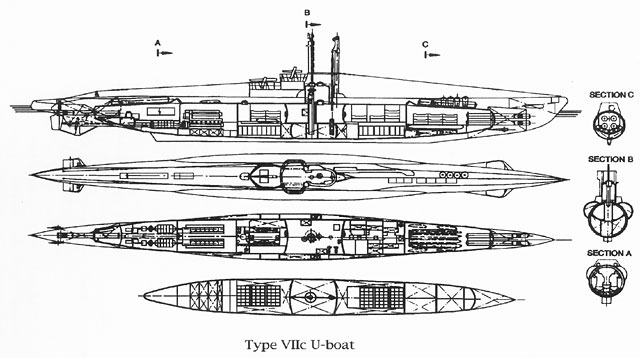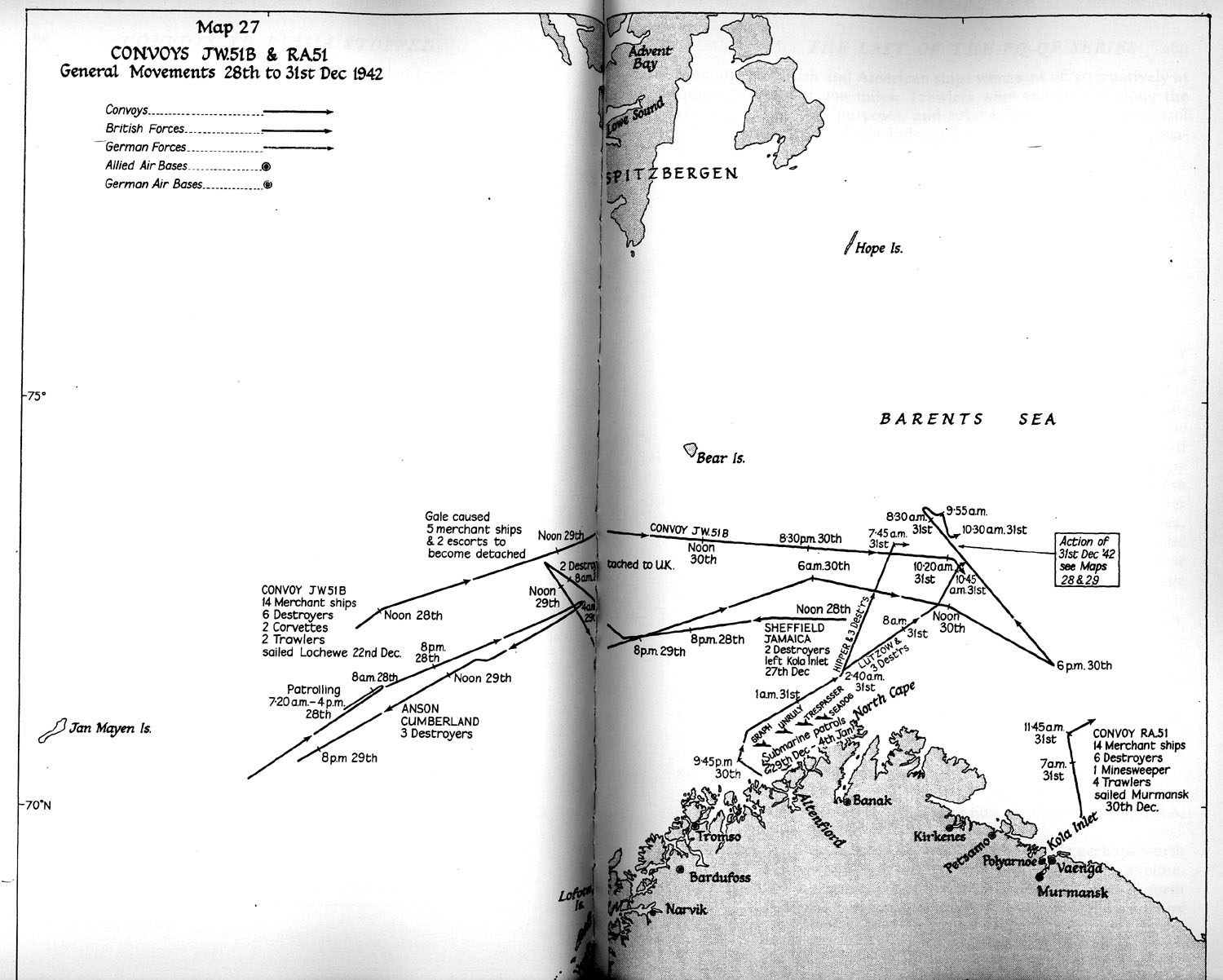|
Operation Doppelschlag
Operation Doppelschlag (Operation Double Blow/) was a German plan for a sortie in 1942 during the Second World War into the Arctic Ocean by the . The operation followed , against Convoy PQ 17 in July 1942 to attack Convoy PQ 18 the next Arctic convoy of the Western Allies. Background Following the victorious operation against Convoy PQ 17 (27 June – 10 July 1942), the was keen to repeat the success. A plan was made to bring a powerful force of cruisers and destroyers against the next PQ convoy to destroy it. The Allies wished to avoid running another convoy in the continuous daylight of the Arctic summer and deferred passage of Convoy PQ 18 and its reciprocal Convoy QP 15 until later in the year. The German forces spent over two months at readiness before the convoys sailed in early September 1942. Plan At first resembled in that the forces involved would wait in readiness at their bases until a convoy was detected, whilst a patrol line of U-boats ( Wolfpack (Ice Pa ... [...More Info...] [...Related Items...] OR: [Wikipedia] [Google] [Baidu] |
Sortie
A sortie (from the French word meaning ''exit'' or from Latin root ''surgere'' meaning to "rise up") is a deployment or dispatch of one military unit, be it an aircraft, ship, or troops, from a strongpoint. The term originated in siege warfare. In siege warfare In siege warfare, the word ''sortie'' refers specifically to a sudden sending of troops against the enemy from a defensive position—that is, an attack launched against the besiegers by the defenders. If the sortie is through a sally port, the verb ''to sally'' may be used interchangeably with ''to sortie''. Purposes of sorties include harassment of enemy troops, destruction of siege weaponry and engineering works, joining the relief force, etc. Sir John Thomas Jones, analyzing a number of sieges carried out during the Peninsular War (1807–1814), wrote: In aviation In military aviation Military aviation is the design, development and use of military aircraft and other flying machines for the purposes of ... [...More Info...] [...Related Items...] OR: [Wikipedia] [Google] [Baidu] |
Narvik
() is the third-largest List of municipalities of Norway, municipality in Nordland Counties of Norway, county, Norway, by population. The administrative centre of the municipality is the Narvik (town), town of Narvik. Some of the notable villages in the municipality include Ankenesstrand, Ballangen (village), Ballangen, Beisfjord, Bjerkvik, Bjørnfjell, Nordland, Bjørnfjell, Elvegården, Kjøpsvik, Skjomen, Håkvik, Hergot, Straumsnes, Narvik, Straumsnes, and Vidrek. The Elvegårdsmoen army camp is located near Bjerkvik. Narvik is located on the shores of the Ofotfjorden. The municipality is part of the Districts of Norway, traditional district of Ofoten of Northern Norway, inside the Arctic Circle. Narvik Municipality borders Hamarøy Municipality to the southwest; Evenes Municipality to the northwest; Bardu Municipality, Gratangen Municipality, Lavangen Municipality, and Tjeldsund Municipality (in Troms county) to the north; and Norrbotten County (Lapland, Sweden, Lapland) in ... [...More Info...] [...Related Items...] OR: [Wikipedia] [Google] [Baidu] |
Type VII Submarine
Type VII U-boats were the most common type of Nazi Germany, German World War II U-boat. 704 boats were built by the end of the war. The type had several modifications. The Type VII was the most numerous U-boat type to be involved in the Battle of the Atlantic. The lone surviving example, , is on display at the Laboe Naval Memorial located in Laboe, Schleswig-Holstein, Germany. At the start of the Second World War the ''Type VII'' class wastogether with the British British U-class submarine, ''U'', British S-class submarine (1931), ''S'' and British T-class submarine, ''T'' class and Dutch O 21-class submarine, ''O 21'' classone of the most advanced submarine classes in service. Design After the defeat in World War I, the Treaty of Versailles forbade Germany to build submarines. Germany circumvented the treaty by setting up the Netherlands, Dutch dummy company ''NV Ingenieurskantoor voor Scheepsbouw Den Haag'' (I.v.S) which continued to design submarines. Based on the World Wa ... [...More Info...] [...Related Items...] OR: [Wikipedia] [Google] [Baidu] |
Heino Bohmann
Heinz Georg Kramm (born 13 December 1938), known professionally as Heino, is a German singer of Schlager and traditional Volksmusik. Having sold a total of over 50 million records, he is one of the most successful German musicians of all time. Heino is known for his baritone voice and trademark combination of light blond hair and dark sunglasses (which he wears due to exophthalmos). He lives in the town of Bad Münstereifel, where he owned a café until June 2012. His interest in music started at age 10 when his mother gave him an accordion in 1948, although his family could barely afford it. Early life Heino was born on 13 December 1938 in Düsseldorf-Oberbilk, Germany, to Heinrich and Franziska Kramm. His father was a Roman Catholic dentist, his mother a Protestant. His grandfather was the organist at the Cathedral of Cologne. He also had two cousins who were Catholic priests. Heino's father was drafted into the German army during World War II, and was killed on 2 August ... [...More Info...] [...Related Items...] OR: [Wikipedia] [Google] [Baidu] |
Battle Of The Barents Sea
The Battle of the Barents Sea was a World War II naval engagement on 31 December 1942 between warships of the German Navy (''Kriegsmarine'') and British ships escorting Convoy JW 51B to Kola Inlet in the USSR. The action took place in the Barents Sea north of North Cape, Norway. The German raiders' failure to inflict significant losses on the convoy infuriated Hitler, who ordered that German naval strategy would henceforth concentrate on the U-boat fleet rather than surface ships. Background Convoy JW 51B Convoy JW 51B comprised fourteen merchant ships carrying war materials to the USSR, about 202 tanks, 2,046 vehicles, 87 fighters, 33 bombers, of fuel, of aviation fuel and just over of other supplies. They were protected by the destroyers , , , , and , with the s and , the minesweeper and trawlers and . The escort commander was Captain Robert Sherbrooke (in ''Onslow''). The convoy sailed in the dead of winter to preclude attacks by German aircraft like those that had ... [...More Info...] [...Related Items...] OR: [Wikipedia] [Google] [Baidu] |
Convoy JW 51B
Convoy JW 51B was an Arctic convoy sent from United Kingdom by the Western Allies to aid the Soviet Union during the Second World War. It sailed in late December 1942, reaching the Soviet northern ports in early January 1943. Convoy JW 51B came under attack by German surface units, engaged in Operation Regenbogen, on 31 December. In the engagement, a British minesweeper and a British destroyer were sunk and a German destroyer were sunk; no ships were lost from the convoy in what became known as the Battle of the Barents Sea. Background Convoy escorts Convoy JW 51A consisted of 15 merchant ships which departed from Loch Ewe on 22 December 1942. Close escort was provided by the minesweeper , two corvettes and two armed trawlers. The close escort was supported by six Home Fleet destroyers led by (Captain Robert Sherbrooke). The convoy sailed with a local escort group from Britain and was joined later by a local escort group from Murmansk. A cruiser cover force comprising , and t ... [...More Info...] [...Related Items...] OR: [Wikipedia] [Google] [Baidu] |
Operation Regenbogen (Arctic)
Operation Rainbow () was a 1942 sortie into the Arctic Ocean by warships of the Nazi German (German Navy) during the Second World War. The operation culminated in the Battle of the Barents Sea. Background Following the disastrous Convoy PQ 17 and the hard-fought Convoy PQ 18 battles in the summer and autumn of 1942 and the needs of Operation Torch in the Mediterranean, Allied convoys to the Soviet Union had been temporarily suspended. In December 1942 Arctic convoys resumed with a new JW/RA convoy series. The had concentrated a large force of surface vessels and U-boats, supported by the aircraft of (Air Fleet 5) of the . German plan was based on a plan to intercept the next Allied convoy to Murmansk. A patrol line of four U-boats was established off Bear Island and a surface force consisting of the cruisers and Lützow with six destroyers was assembled at Altafjord. When a convoy was spotted, the fleet would sail as two battle groups; one to engage the expected crui ... [...More Info...] [...Related Items...] OR: [Wikipedia] [Google] [Baidu] |
Luftflotte 5
Luftflotte 5 (Air Fleet 5) was one of the primary divisions of the German Luftwaffe in World War II. It was formed 12 April 1940 in Hamburg for the invasion of Norway. It transferred to Oslo, Norway on 24 April 1940 and was the organization responsible for Luftwaffe activity in Occupied Norway throughout the Second World War. History Luftflotte 5 was responsible for German air operations during the invasion of Norway, and for the defence of the occupied territory thereafter. It was divided into various operational formations, governing air forces, and into Air Districts (''Luftgau'') controlling ground forces and facilities. In 1940, for the invasion, its main air asset was '' Fliegerkorps X'', a formation comprising four bomber and one fighter wings (''Geschwader'') together with air support forces. With the conclusion of the Norwegian campaign Fliegerkorps X was moved to other theatres (first to the Battle of Britain, then to the Mediterranean Sea). On 15 August 1940 the ''Lu ... [...More Info...] [...Related Items...] OR: [Wikipedia] [Google] [Baidu] |
Hans-Jürgen Stumpff
Hans-Jürgen Stumpff (15 June 1889 – 9 March 1968) was a German general during World War II and was one of the signatories to Germany's unconditional surrender at the end of the war. Military career Stumpff joined the Grenadier Regiment "Prince Carl of Prussia" (2nd Brandenburg) No. 12 of the Prussian Army on 2 September 1907 as a Ensign and served on the General Staff during World War I with the rank of Captain. During the Weimar Republic, he served as a staff officer in the Reichswehrministerium. On 1 September 1933, Stumpff, with the rank of lieutenant colonel, became head of personnel in the (illegal) Luftwaffe. After the Luftwaffe became formally legal in Germany because of the Nazis rejection of the terms of the Treaty of Versailles, Stumpff served as its chief of staff from 1 June 1937 until 1 January 1939, when he was succeeded by Hans Jeschonnek In 1938, Stumpff was promoted to the rank of General der Flieger. During the Second World War, Stumpff commanded variou ... [...More Info...] [...Related Items...] OR: [Wikipedia] [Google] [Baidu] |




